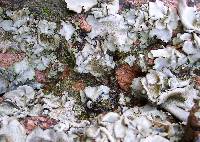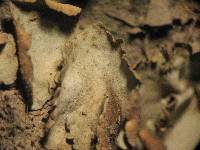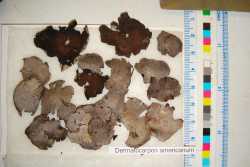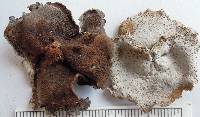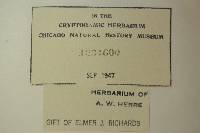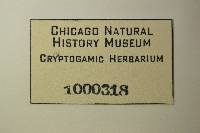
Consortium of Lichen Herbaria
- building a Global Consortium of Bryophytes and Lichens as keystones of cryptobiotic communities -
- Home
- Search
- Images
- Species Checklists
- US States: O-Z >
- US National Parks
- Central America
- South America
- US National Parks
- Southern Subpolar Region
|
|
|
|
Family: Verrucariaceae
|
Nash, T.H., Ryan, B.D., Gries, C., Bungartz, F., (eds.) 2004. Lichen Flora of the Greater Sonoran Desert Region. Vol 2. Thallus: foliose, single-lobed attached by a single umbilicus and with 17-60 mm wide lobes upper surface: gray, with epinecral layer consisting of air filled hyphae upper cortex: 80-140 µm thick, hyaline with the outermost 1030 µm dark brown algal layer: 60-120 µm thick, mainly located in the lower part of the upper cortex medulla: 140-400 µm thick, of filamentous hyphae, turning red with Melzer's iodine lower cortex: 60-90 µm thick, with the outermost 10-40 µm brown lower surface: light to dark brown, usually with reticulated wrinkles at least partly but can also be smooth, rugose or verrucose Perithecia: broadly obpyriform to globose, 200-400 µm high and 200330 µm wide, with a hyaline exciple that is light brown to brown in the uppermost part asci: clavate, 8-spored ascospores: simple, hyaline, 10-14 x 5-7 µm Pycnidia: rare, immersed conidia: not found Spot tests: all negative Secondary metabolites: none detected. Substrate and ecology: on different types of rocks, often in seepages (at least seasonal) World distribution: North America, from the U.S.A. and Mexico Sonoran distribution: throughout Arizona, southern California, Baja California, Baja California Sur, Chihuahua, and Sonora. Notes: Dermatocarpon americanum is characterized by the medulla reaction with Melzer's iodine. This overlooked name is the correct one, for a part of what has usually been called D. miniatum (L.) Mann. in the southern part of North America. |
|
|
|
Powered by Symbiota









